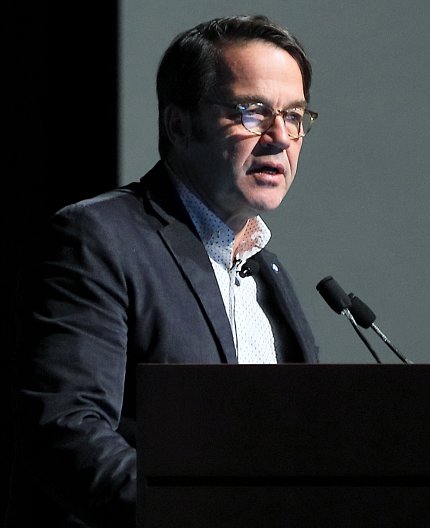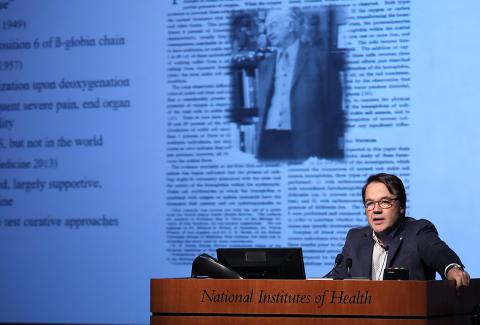Tisdale Explores Multiple Avenues Toward Curing SCD

Photo: Chia-Chi Charlie Chang
It’s a brutal, life-threatening condition. People living with sickle cell disease (SCD) endure chronic, debilitating pain. This inherited blood disorder has a cure, though it’s not widely available, a predicament that has inspired NIH investigators to pursue novel treatments that would be more accessible, particularly in parts of the world where the disease is most prevalent.
“It’s time to envision broadly available cures for this disease,” said Dr. John Tisdale, senior investigator in the National Heart, Lung and Blood Institute, who continues to pioneer several strategies in the lab and clinic to cure SCD. He spoke recently to a packed Masur Auditorium at the 14th annual Philip S. Chen, Jr., Ph.D. Distinguished Lecture on Innovation and Technology Transfer.
SCD is a single-gene disorder that produces abnormal hemoglobin. “This causes red blood cells that are very fragile,” explained Tisdale, “resulting in a severe anemia of red cells that also become rigid and don’t pass through the circulation, causing frequent, severe pain, organ damage and, ultimately, early mortality in the 40s, even in the modern era.”
While rare in the United States, afflicting about 100,000 Americans, SCD is rampant globally. More than 20 million people have the disease worldwide, with the highest rates in sub-Saharan Africa and India. Current treatments are limited to supportive care with blood transfusions and pain medication, said Tisdale, who underscored the need for more clinical trials to test new treatments.
The existing cure, a bone marrow transplant, is most effective in patients who have a fully matched sibling, but most SCD patients lack an ideal donor. And for the millions suffering with SCD around the world, most live in places that lack adequate blood banks, making a bone marrow transplant or blood transfusion unavailable to them.
For the lucky patients who have a transplant donor and access to the procedure, the infusion of new bone marrow stem cells produces all types of blood cells for the patient’s lifetime, explained Tisdale. While the greatest chances of success are with a healthy matched sibling, there’s growing success with half-matched family members.
“In the modern era, children can expect a 95 percent chance of being cured with a bone marrow transplant if they have a matched sibling,” said Tisdale, “but some of these children had an apparent cure even when their bone marrow wasn’t completely replaced by their donor.”
This result led Tisdale’s team to study whether SCD patients could be cured without ablating—using radiation or chemotherapy to destroy—bone marrow stem cells. They’re currently testing a new drug showing long-term tolerance in the lab that is given in conjunction with another drug to protect against graft vs. host disease, a severe, potentially deadly complication of transplant. In the first 9 of 10 transplant patients, the chemotherapy-free transplant using these drugs resolved anemia and sickle cell symptoms while preventing graft vs. host disease, reported Tisdale. In further testing, SCD reversed in 87 percent of patients, most of whom are now off immunosuppression and pain medication.
The low toxicity from this chemotherapy-free approach makes it a viable option for adults with severe SCD and related organ damage, said Tisdale. The therapy could be used even in patients on dialysis or with significant heart disease.

Photo: Chia-Chi Charlie Chang
In their journey toward improved treatments, Tisdale’s team next sought to determine how much corrected bone marrow would be enough to fix SCD. In long-term follow-up with 100 transplant patients, they identified three patients who, despite robust initial engraftment, experienced steady decline. When white cells that came from the donor fell below 20 percent, Tisdale said, the patients had recurrent anemia and symptoms.
The protocol results led Tisdale to examine whether gene therapy could help achieve that modest 20 percent mark. Autologous gene therapy removes and corrects the patient’s own bone marrow by adding a beta globin gene. When infused into the patient through an engineered viral vector, the corrected gene prompts the body to start producing healthy hemoglobin.
Tisdale had been studying gene therapy strategies for 25 years. “We really had a lot of work to do before we moved [gene therapy from the lab] to the clinic,” he said.
One major hurdle was figuring out if hematopoiesis (blood cell generation) from genetically modified cells was sustainable. Long hours in the lab led Tisdale to find that a polyclonal model of blood formation that yielded long-term correction was indeed possible with gene transfer, a strategy incorporated into the first successful gene therapy trials in humans.
At least 27 SCD patients have undergone experimental gene therapy, with promising results. Meanwhile, Tisdale continues to develop new, more efficient viral vectors to improve success rates.
Yet another tantalizing approach is gene editing. Still in the early phases of development, this procedure takes the patient’s bone marrow and allows either cutting a gene that represses fetal hemoglobin to permit its reactivation in place of the sickle hemoglobin or cutting and correcting the disease-causing mutation.
“[The CRISPR-Cas9 gene-editing tool] has really revolutionized basic molecular biology due to its accuracy and ease of use, and it’s relatively inexpensive,” said Tisdale. “We’re hopeful this will pave the way for new therapeutics.”
While gene therapy clinical trials continue, Tisdale is also focused on testing drugs that could reactivate fetal hemoglobin in an effort to find a treatment that is more readily available to resource-poor areas where the disease is more prevalent.
“It should be easy, unlike cancer, with so many genetic mutations that differ so much from patient to patient,” said Tisdale. “We have one gene; it’s the same in every patient. We don’t need custom-made reagents for each patient…We should be able to fix this.”
